
Clitheroe is a town and civil parish in the Borough of Ribble Valley, Lancashire, England; it is located 34 miles (55 km) north-west of Manchester. It is near the Forest of Bowland and is often used as a base for tourists visiting the area. In 2018, the Clitheroe built-up area had an estimated population of 16,279.

Ribble Valley is a local government district with borough status in Lancashire, England. Its council is based in Clitheroe, the largest town. The borough also includes the town of Longridge and numerous villages and surrounding rural areas. It is named after the River Ribble. Much of the district lies within the Forest of Bowland, a designated Area of Outstanding Natural Beauty.

Blackburn railway station serves the town of Blackburn in Lancashire, England. It is 12 miles (19 km) east of Preston and is managed and served by Northern Trains.
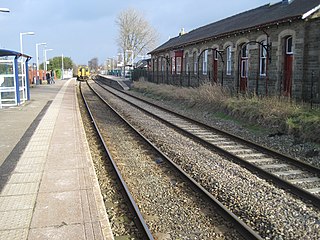
The Ribble Valley line is a railway line that runs from Manchester Victoria through Blackburn to Hellifield in Lancashire. Regular passenger services normally run as far as Clitheroe, but occasional passenger services run the whole line through north Lancashire towards the Yorkshire village of Hellifield, where it joins the Settle–Carlisle line. The line passes over the distinctive 48-span Whalley Viaduct.

Green Park railway station is a former railway station in Bath, Somerset, England. For most of its life, it was known as Bath Queen Square.

Bromley Cross railway station, on Chapeltown Road in Bromley Cross, a suburb to the north of Bolton, England, is served by the Northern 'Ribble Valley' line 2+3⁄4 miles (4.4 km) north of Bolton. The station is just south of the point where the double line merges into one.

Warrington Central railway station is one of three main railway stations serving the town of Warrington in Cheshire, England. It is located on the southern route of the Liverpool to Manchester Lines, being situated approximately halfway between the two cities.

Sankey railway station, also known as Sankey for Penketh, is a railway station in the west of Warrington, Cheshire, England, serving the Great Sankey, Penketh and Whittle Hall areas of the town. The station, and all trains serving it, are operated by Northern Trains. It is designated by English Heritage as a Grade II listed building.
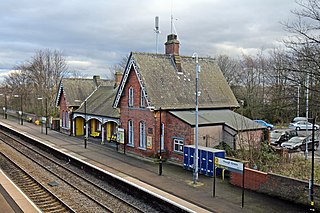
Hough Green railway station is a railway station to the west of Widnes in Halton, Cheshire, England. It is recorded in the National Heritage List for England as a designated Grade listed building. The station is on the Liverpool–Warrington–Manchester line 10 miles 42 chains (16.9 km) east of Liverpool Lime Street and all trains serving it are operated by Northern Trains.
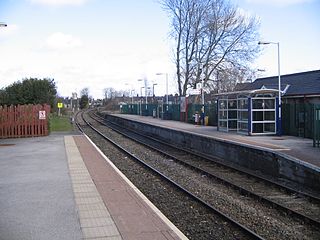
Clitheroe railway station serves the town of Clitheroe in Lancashire, England. The station is the northern terminus of the Ribble Valley Line / Clitheroe Line operated by Northern Trains and is 10 miles (16 km) north of Blackburn. The station forms part of Clitheroe Interchange, which has won a number of awards.

Barnoldswick railway station was the only railway station on the Midland Railway's 1-mile-64-chain (2.9 km) long Barnoldswick Branch in the West Riding of Yorkshire in England. It served the market town of Barnoldswick, which was in West Riding of Yorkshire at the time. The line left the Leeds and Bradford Extension Railway at Barnoldswick Junction 55 chains from Earby railway station. The line through the junction was on a 20-chain radius after which it converged to a single track and ran in a straight but undulating line to Barnoldswick. The passenger train that ran back and forth between Barnoldswick and Earby was known locally as the 'Barlick Spud' or 'Spudroaster'. The real reason for the name is lost in time, but the two versions that were commonly recited are that the original branch locomotive was so small it looked like a portable potato roaster used by a local vendor or that the journey time was the same as that taken to roast a potato in the locomotive's firebox.

Chatburn is a village, civil parish and electoral ward in the Ribble Valley, East Lancashire, England. The population of the civil parish at the 2011 census was 1,102. Situated in a hollow between two ridges north-east of Clitheroe, just off the A59 road, relatively near Pendle Hill south-east of the village. Lanehead quarry is situated to the West at the termination of Chatburn Old Road. Ribble lane at 240 above sea level leads down to the River Ribble North of the village, the top of Downham road being 150 feet higher.

Sabden is a village and civil parish in the Ribble Valley, Lancashire, England. Sabden is located south of Pendle Hill, in a valley about three miles north west of Padiham. The parish covers 2,450.9 acres (991.85 ha), of which 103.2 acres (41.75 ha) is occupied by the village. It lies in the Forest of Pendle section of the Forest of Bowland Area of Outstanding Natural Beauty.

Gisburn is a village and civil parish within the Ribble Valley borough of Lancashire, England. Historically within the West Riding of Yorkshire, it lies 8 miles (13 km) northeast of Clitheroe and 11 miles (18 km) west of Skipton. The civil parish had a population of 506, recorded in the 2001 census, increasing to 521 at the 2011 Census.

Rimington is a rural village and civil parish in the Ribble Valley, Lancashire, England. The population of the civil parish was 382 at the 2001 Census, however at the 2011 Census Middop was included with Rimington giving a total of 480. It is east of Clitheroe and south of the A59 road. The village consists of the hamlets of Howgill, Martin Top, Newby, and Stopper Lane, and is in the historic West Riding of Yorkshire.
Manchester Oldham Road station opened in 1839 as the terminus station of the Manchester and Leeds Railway (M&LR) in Collyhurst, Manchester. When the M&LR opened Manchester Victoria in 1844 as its new Manchester passenger station Oldham Road was converted to a goods station which it remained until its closure in 1968.
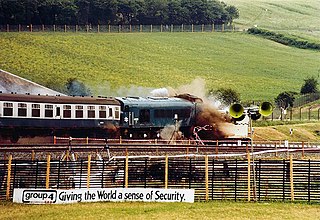
Old Dalby railway station served Old Dalby in the English county of Leicestershire. It was opened on the Nottingham direct line of the Midland Railway between London and Nottingham, avoiding Leicester. The line still exists today as the Old Dalby Test Track.
Twiston is a village and a civil parish in the Ribble Valley District, in the English county of Lancashire. It is near the town of Clitheroe and the village of Downham. The parish is part of the Forest of Bowland Area of Outstanding Natural Beauty (AONB). It adjoins the Ribble Valley parishes of Downham and Rimington, and the Pendle parish of Barley-with-Wheatley Booth.
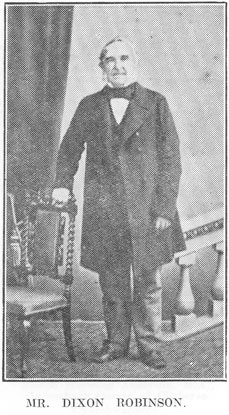
Dixon Robinson (1795–1878) was an English lawyer, gentleman steward of the Honour of Clitheroe, and philanthropist in the 19th century.

Bricklayers Arms was a railway station in Southwark opened by the London and Croydon Railway and the South Eastern Railway in 1844 as an alternative to the London and Greenwich Railway's terminus at London Bridge. The station was at the end of a short branch line from the main line to London Bridge and served as a passenger terminus for a few years before being converted to a goods station and engineering facility. The goods station closed in 1981.

















